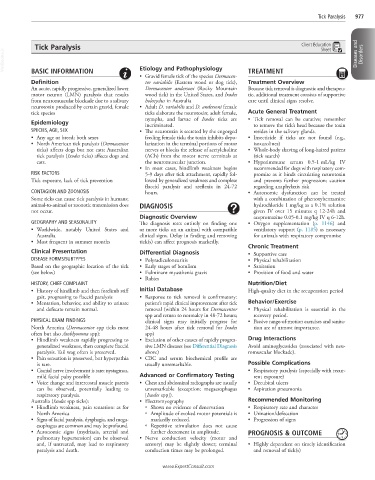Page 1953 - Cote clinical veterinary advisor dogs and cats 4th
P. 1953
Tick Paralysis 977
Tick Paralysis Client Education
Sheet
VetBooks.ir Etiology and Pathophysiology Diseases and Disorders
BASIC INFORMATION
• Gravid female tick of the species Dermacen- TREATMENT
Definition tor variabilis (Eastern wood or dog tick), Treatment Overview
An acute, rapidly progressive, generalized lower Dermacentor andersoni (Rocky Mountain Because tick removal is diagnostic and therapeu-
motor neuron (LMN) paralysis that results wood tick) in the United States, and Ixodes tic, additional treatment consists of supportive
from neuromuscular blockade due to a salivary holocyclus in Australia care until clinical signs resolve.
neurotoxin produced by certain gravid, female • Adult D. variabilis and D. andersoni female
tick species ticks elaborate the neurotoxin; adult female, Acute General Treatment
nymphs, and larvae of Ixodes ticks are • Tick removal can be curative; remember
Epidemiology incriminated. to remove the tick’s head because the toxin
SPECIES, AGE, SEX • The neurotoxin is secreted by the engorged resides in the salivary glands.
• Any age or breed; both sexes feeding female tick; the toxin inhibits depo- • Insecticide if ticks are not found (e.g.,
• North American tick paralysis (Dermacentor larization in the terminal portions of motor isoxazolines)
ticks) affects dogs but not cats; Australian nerves or blocks the release of acetylcholine • Whole-body shaving of long-haired patient
tick paralysis (Ixodes ticks) affects dogs and (ACh) from the motor nerve terminals at (tick search)
cats. the neuromuscular junction. • Hyperimmune serum 0.5-1 mL/kg IV
• In most cases, hindlimb weakness begins recommended for dogs with respiratory com-
RISK FACTORS 5-9 days after tick attachment, rapidly fol- promise as it binds circulating neurotoxin
Tick exposure, lack of tick prevention lowed by generalized weakness and complete and prevents further progression; caution
flaccid paralysis and areflexia in 24-72 regarding anaphylaxis risk
CONTAGION AND ZOONOSIS hours. • Autonomic dysfunction can be treated
Some ticks can cause tick paralysis in humans; with a combination of phenoxybenzamine
animal-to-animal or zoonotic transmission does DIAGNOSIS hydrochloride 1 mg/kg as a 0.1% solution
not occur. given IV over 15 minutes q 12-24h and
Diagnostic Overview acepromazine 0.05-0.1 mg/kg IV q 6-12h.
GEOGRAPHY AND SEASONALITY The diagnosis rests entirely on finding one • Oxygen supplementation (p. 1146) and
• Worldwide, notably United States and or more ticks on an animal with compatible ventilatory support (p. 1185) as necessary
Australia clinical signs. Delay in finding and removing for animals with respiratory compromise
• Most frequent in summer months tick(s) can affect prognosis markedly.
Chronic Treatment
Clinical Presentation Differential Diagnosis • Supportive care
DISEASE FORMS/SUBTYPES • Polyradiculoneuritis • Physical rehabilitation
Based on the geographic location of the tick • Early stages of botulism • Sanitation
(see below) • Fulminant myasthenia gravis • Provision of food and water
• Rabies
HISTORY, CHIEF COMPLAINT Nutrition/Diet
• History of hindlimb and then forelimb stiff Initial Database High-quality diet in the recuperation period
gait, progressing to flaccid paralysis • Response to tick removal is confirmatory:
• Mentation, behavior, and ability to urinate patient’s rapid clinical improvement after tick Behavior/Exercise
and defecate remain normal. removal (within 24 hours for Dermacentor • Physical rehabilitation is essential in the
spp and return to normalcy in 48-72 hours; recovery period.
PHYSICAL EXAM FINDINGS clinical signs may initially progress for • Passive range-of-motion exercises and sanita-
North America (Dermacentor spp ticks most 24-48 hours after tick removal for Ixodes tion are of utmost importance.
often but also Amblyomma spp): spp)
• Hindlimb weakness rapidly progressing to • Exclusion of other causes of rapidly progres- Drug Interactions
generalized weakness, then complete flaccid sive LMN diseases (see Differential Diagnosis Avoid aminoglycosides (associated with neu-
paralysis. Tail wag often is preserved. above) romuscular blockade).
• Pain sensation is preserved, but hyperpathia • CBC and serum biochemical profile are
is rare. usually unremarkable. Possible Complications
• Cranial nerve involvement is rare; nystagmus, • Respiratory paralysis (especially with recur-
mild facial palsy possible Advanced or Confirmatory Testing rent exposure)
• Voice change and intercostal muscle paresis • Chest and abdominal radiographs are usually • Decubital ulcers
can be observed, potentially leading to unremarkable (exception: megaesophagus • Aspiration pneumonia
respiratory paralysis. [Ixodes spp]).
Australia (Ixodes spp ticks): • Electromyography Recommended Monitoring
• Hindlimb weakness, pain sensation: as for ○ Shows no evidence of denervation • Respiratory rate and character
North America ○ Amplitude of evoked motor potentials is • Urination/defecation
• Signs of facial paralysis, dysphagia, and mega- markedly reduced. • Progression of signs
esophagus are common and may be profound. ○ Repetitive stimulation does not cause
• Autonomic signs (mydriasis, arterial and further decrement in amplitude. PROGNOSIS & OUTCOME
pulmonary hypertension) can be observed • Nerve conduction velocity (motor and
and, if untreated, may lead to respiratory sensory) may be slightly slower; terminal • Highly dependent on timely identification
paralysis and death. conduction times may be prolonged. and removal of tick(s)
www.ExpertConsult.com

